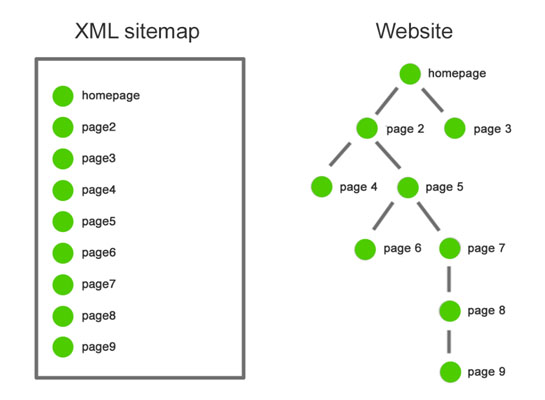XML Sitemap
An XML (Extensible Markup Language)Sitemap is specially written for search engine crawler. A search engine crawler can quickly and easily extract all the important piece of information about your site by looking at the XML file.
In simple terms, an XML sitemap is a list of your website’s URLs.
A Sitemap is an XML file that lists URLs for a site along with additional metadata about each URL, such as, when it was last updated, how often it usually changes, and how important it is? So that search engines can more intelligently crawl the site.
It acts as a roadmap to tell search engines what content is available and how to reach it.

In the example above, a search engine will find all nine pages in a sitemap with one visit to the XML sitemap file.
On the website, it will have to jump through five internal links to find page 9.
XML Sitemap Format
The Sitemap must,
- Begin with an opening <urlset> tag and end with a closing </urlset> tag.
- Specify the namespace (protocol standard) within the <urlset> tag.
- Include a <url> entry for each URL, as a parent XML tag.
- Include a <loc> child entry for each <url> parent tag.
All other tags are optional. Also, all URLs in a Sitemap must be from a single host.
The following example shows a Sitemap that contains just one URL and uses all optional tags.
Code Sample
<?xml version=”1.0″ encoding=”UTF-8″?>
<urlset xmlns=”http://www.sitemaps.org/schemas/sitemap/0.9″>
<url>
<loc> http://www.example.com/ </loc>
<lastmod> 2020-01-01 </lastmod>
<changefreq> monthly </changefreq>
<priority> 0.8 </priority>
</url>
</urlset>
XML Sitemap Generator Tool (Website)
https://www.seoptimer.com/sitemap-generator
XML Sitemap Tags
1. <urlset>
It references the current protocol standard.
2. <url>
This is a parent tag for each URL entry. The remaining tags are children of this tag.
3. <loc>
It is a URL of the page. This URL must begin with the protocol, such as http or https and end with a trailing slash (/), if your web server requires it.
4. <lastmod>
This is a date of last modification of the file. This date should be in YYYY-MM-DD format.
5. <changefreq>
How frequently the page is likely to change.
Valid values are:
- always
- hourly
- daily
- weekly
- monthly
- yearly
- never
The value “always” should be used to describe documents that change each time they are accessed. The value “never” should be used to describe archived URLs.
6. <priority>
This is the priority of URL, relative to other URLs on your site. Valid values range from 0.0 to 1.0




























Add comment